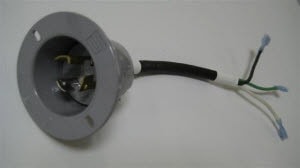There are several factors to consider when choosing an electrical wire or cable. However, the most important factors to take into account are the electrical requirements of your application.
Selecting an Appropriate Wire or Cable
Mentioned below are the electrical requirements to consider when selecting an appropriate wire or cable.
- Current Carrying Capacity: This term refers to the calculation of the amount of current a cable can carry. The current carrying capacity of the wire or cable is directly proportional to its size. Current is expressed in amperes (Amp). The larger the wire size, the more current it can carry.
- Inductance: Inductance is the property of a wire or circuit that induces an electromotive force when the value of current changes. It causes the voltage to lag behind. This can occur in the same wire, or in a neighboring wire. It is expressed in microhenries per foot (μH/Ft). Higher inductance can hinder the flow of current in the wire.
- Impedance: Electrical impedance is the total opposition that a circuit or wire presents to the alternating current (AC) when voltage is applied. Impedance is expressed in Ohms (Ω). The length of the cable has no effect of its impedance, but the impedance at the transmitting and receiving end should be same.
- Capacitance: Capacitance is the measure of the amount of charge a cable can store within itself. Capacitance is expressed in Pico farad per foot (pF/ft). High capacitance can hamper the performance of a cable at high frequencies.
- Resistance: The electrical resistance of a cable is a measure of the difficulty it faces in passing an alternating current (AC) through it when voltage is applied. It is expressed in Ohms (Ω). There should be little to no resistance in a cable or wire.
- Velocity of Propagation (Vp): This term refers to the speed at which a signal travels through the length of a cable compared to its speed in free air. In practical applications, a cable slows the speed of electrical signals. This slowing effect is directly dependent on the dielectric material of the cable. Vp is expressed as a percentage of the speed of signal in free space. The lower the Vp, the longer the delay. Hence, choose a wire with high Vp percentage.
- Voltage (Volt): It is the measurement of electrical pressure along the conductor wire. The voltage rating is directly proportional to the insulation thickness of a cable. The thicker the insulation, the higher the voltage rating. Following are the generally used insulation thicknesses and maximum permitted voltage:
- 0.016″ insulation = 300 volts (UL Standards)
- 0.010″ insulation = 600 volts (Military Specifications)
- 0.016″ insulation = 1000 volts (Military Specifications)
- 0.032″ insulation = 600 volts (UL Standards)
Following these guidelines will help you choose a high-performance, and durable wire or cable. If you need further assistance, contact an expert manufacturer, he will be happy to help you choose the appropriate cable for your application.

